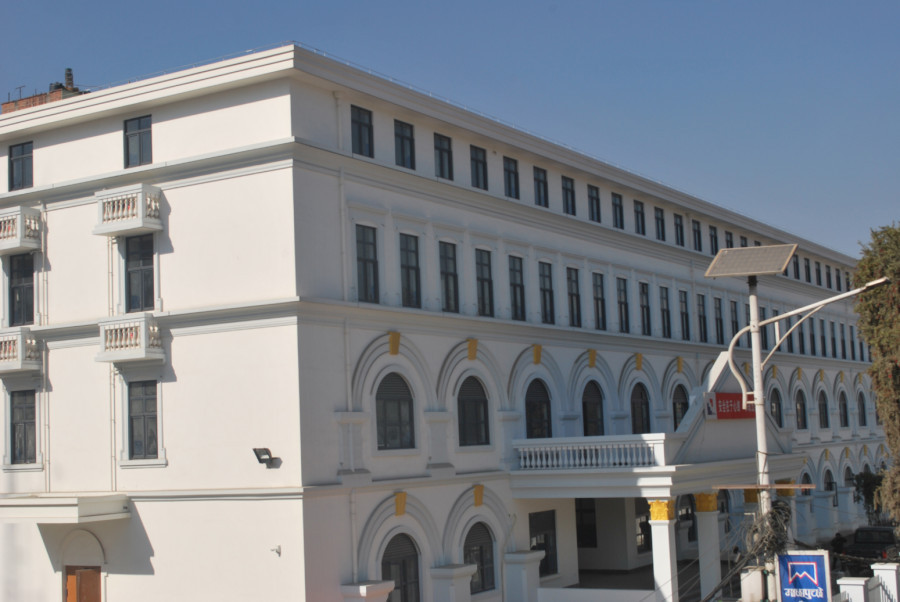Valley
With its new building, Durbar High School attracts students from private schools
Parents who no longer could afford to send their kids to private schools as their incomes were shrunk by the pandemic are now looking at the government school as an alternative.
Anup Ojha
Sunday was the first day of school for Anjelica Tamrakar. The ninth grader, who was studying at a private school in Kathmandu, is now attending a government school at the heart of Kathmandu—one of the oldest in the country.
“I sat for the entrance exam a week ago, and classes started on Sunday,” said Tamrakar, one of the new students at Durbar High School, which was ravaged by the 2015 earthquake and recently rebuilt with Chinese aid at the cost of Rs850 million.
“I am trying to adjust with the situation here. But I love all the new things,” said Tamrakar, who is happy to learn Sanskrit at the school.
Tamrakar is one of the new students at the government school, which now boasts a computer lab, science labs, an auditorium hall and a canteen better than most private schools in the Valley.
The Durbar High School building is shared by two schools: Bhanu School, which runs classes during the day, and the Sanskrit School that runs morning shifts.
“Over sixty percent of the new students have come from private schools,” said Akhilesh Azad, principal of Bhanu School. “We received a lot of applications and we had to be very selective when enrolling students,” said Azad.
“Many parents complained that private schools charge them exorbitant fees even when their children didn’t attend classes in the name of online classes, which were not effective,” said Azad.
“As we have enrolled 150 new students, the number of students at our school has now gone up to 300,” he told the Post.
Tamrakar’s mother Maita, who was forced to close her shop in Sitapaila over four months ago says sending her daughter to Durbar High School has eased her financial burden. “I paid Rs 1,950 for my daughter’s admission. I would have been charged over Rs 60,000 in annual fees if we had gone to a private school,” said Maita, 46, who fractured her hand in June and could not continue her business.
Although President Bidya Devi Bhandari inaugurated the newly restored building in December last year, the school had only until now resumed classes for grades 11 and 12.
But on Sunday, the school opened its doors for around 600 students from both Bhanu and Sanskrit schools. The school only has 35 teachers—17 in Sanskrit and 18 in Bhanu school.
Karishma Basnet, 15, another newly enrolled student in grade nine said two of her siblings are now enrolled in the same school—one in grade one and the other in grade eight. “The infrastructure is far better than my previous school, and it will provide a great economic relief for my family,” said Basnet.
Uma Basnet, Karishma’s mother, said she got her three children enrolled at Durbar School after she could not pay exorbitant fees at their previous school.
“How could I pay Rs75,000 for my kids who didn’t go to school over nine months?” said the mother of three who lives in a rented room and has been left unemployed following the nationwide lockdown.
“The school has good infrastructure and the school has assured us that it will provide quality education,” said Uma.
For the past four years students from both the schools were taught at the Temporary Learning Centre constructed by the Chinese government on the premises of Balmiki Vidyapith Mahavidyalaya in Pradarshani Marg.
Mahesh Budha, a 10th grade student from Humla, said he is happy that he can now study in the new building.
“I feel as if I am somewhere else. Earlier the roof over our classroom leaked when it rained, and we spent four years in a congested room,” remembers Budha.
“The school has also added a few new teachers. Everything looks really good here,” said Budha.
“We now have really good infrastructure, and the number of students who want to study here has gone up,” said Shiva Raj Adhikari, principal at the Sanskrit school that has been running classes for grades six to 10. He said his school enrolled 167 new students this year.
Adhikari said that the school has been talking to Kathmandu Metropolitan City’s Education Department to hire more teachers.
Ram Prasad Subedi, chief of the city's education department, said his office is coming up with a plan to make the school the best public school in the city. “We will soon make the plans public. We are equally concerned about imparting quality education to students,” said Subedi.
Meanwhile, Principal Adhikari believes that Durbar High School’s lost glory will now be restored.
The school’s history dates back to the 1800 when it was a matter of reputation to send one’s children in the school. The Ranas built the school in 1853 to educate the children of the ruling class.
Later, members of the public were also allowed in, but entry was restricted to those from well-off families. Durbar High school, which was renamed Bahnu Secondary School in 1967, was the only English medium School in the country for a long time.
But after the fall of the Rana regime and in 1950 more schools opened in the Valley and Durbar High School gradually lost its sheen.
“I guess the school is going to restore its lost glory. We are equally working to promote English medium as well and Sanskrit and Nepali,” said Adhikari.




 18.12°C Kathmandu
18.12°C Kathmandu.jpg)











